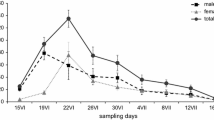Summary
Stabilizing mechanism in population ofMalacosoma neustria testacea was investigated in a central part of Japan based on eight year survey.
Population fluctuation in each developmental stage in the experimental field was rather small, i.e., 5.9 times in egg and 85.0 times in female adult. Pupal weight negatively correlated with the densities of 5th instar larvae and prepupae (cocoons) and correlation coefficient was highly significant in females. Population density was stabilized by density-dependent dispersal of female moths in preovipositional period. Comparison between fecundity of emerged moths and that of actually oviposited ones in the experimental field suggested that density-dependent dispersal took place as the result of density-dependent size variation, i.e., small-sized female months have higher flying ability. This hypothesis was supported by the experiment in which flying ability of newly emerged female moth was measured. Similar stabilizing mechanism is expected to occur in semelparous or pro-ovigenic insects.
Similar content being viewed by others
References
Blais, J. R. (1953) Effects of the destruction of the current year's foliage of balsam fir on the fecundity and habits of the flight of the spruce budworm.Can. Ent. 85: 446–448.
Cole, L. C. (1954) The population consequences of life history phenomena.Quart. Rev. Biol.29: 103–137.
Dempster, J. P. (1968) Intra-specific competition and dispersal: An exemplified by a psyllid and its anthocorid predator.Insect Abundance (Ed. T. R. E. Southwood). 8–17.
Flanders, S. E. (1950) Regulation of ovulation and egg disposal in the parasitic Hymemoptera.Can. Ent.82: 134–140.
Gruys, P. (1971) Mutual interference inBupalus piniarius (Lepidoptera, Geometridae).Proc. adv. Study Inst. Dynamics Numbers Popul. (Oosterbeek, 1970). 199–207.
Hôkyô, N. (1972) Studies on the life history and the population dynamics of the green rice leafhopper,Nephotettix cincticeps Uhler.Bull. Kyushu Agric. Expt. Stn.16: 283–382 (In Japanese with English summary).
Hodson, A. C. (1941) An ecological study of the forest tent caterpillar,Malacosoma disstria Hbn., in northern Minnesota.Tech. Bull. Minn. agric. Exp. Sta.,148: 1–55.
Itô, Y. (1952) The growth form of populations in some aphids, with special reference to the relation between population density and the movements.Res. Popul. Ecol.1: 36–48. (In Japanese with English summary)
Itô, Y. (1953) Studies on the population increase and the movement of soy bean aphid,Aphis glycinesMatsumura. I. On the two types of population increase. II. On the movements from plant to plant.Ôyô-kontû8: 141–148. (In Japanese with English summary)
Itô, Y. (1959)Comparative ecology. Twanami-shoten, Tôkyô. (In Japanese)
Itô, Y. (1960) Ecological studies on population increase and habitat segregation among barley aphids.Bull. Nat. Ins. Agric. Sci., Ser. C.11: 45–130.
Iwao, S. (1962) Studies on the phase variation and related phenomena in some lepidopterous insects.Mem. Coll. Agric., Kyôtô Univ.84: 1–80, 3 pls.
Iwao, S. (1968) Some effects of grouping in lepidopterous insects.Colloq. Int. Centre Nat. Recherche Scientifique173: 185–212.
Iwao, S. (1971) Dynamics of numbers of a phytophagous lady-beetle,Epilachna vigintioctomaculata, living in patchily distributed habitats.Proc. Adv. Study Inst. Dynamics Number Popul. (Oosterbeek, 1970), 129–147.
Kennedy, J. S. (1956) Phase transformation in locust biology.Biol. Rev.31: 349–370.
Kennedy, J. S. (1961) A turning point in the study of insect migration.Nature189: 785–791.
Kuno, E. (1968) Studies on the population dynamics of rice leafhoppers in a paddy field.Bull. Kyushu Agric. Expt. Stn.14: 131–246. (In Japanese with English summary)
Kuno, E. andN. Hôkyô (1970) Comparative analysis of the population dynamics of rice leafhoppers,Nephotettix cincticeps Uhler andNilaparvata lungensStål, with special reference to natural regulation of their numbers.Res. Popul. Ecol12: 154–184.
Kuno, E. andN. Hôkyô (1976) Population regulation and dispersal of adults in the green rice leafhopper,Nephotettix cincticepsUhler (Hemiptera: Deltocephalidae).Physiol. Ecol. Japan17: 117–127. (In Japanese with English summary)
Laux, W. (1962) Individuelle Unterschiede in Verhalted und Leistung des Ringelspinners,Malacosoma neustria (L.).Ztschr. angew. Zool.49: 465–524.
Laux, W. andJ. M. Franz (1962) Über das Auftreten von Individual-unterschieden bein Ringelspinners,Malacosoma neustria (L.)Ztschr. angew. Ent.50: 105–109.
Miyashita, K. (1954) An analysis on the process of increase of green peach aphid population under closed and open conditions.Jap. J. Ecol.4: 16–20 (In Japanese with English summary)
Morisita, M. (1950) Population density and movement of a water strider,Gerris lacustris. Rept. Physiol. & Ecol., Dept. Zool., Kyôtô Univ. No. 65, 149pp. (In Japanese)
Sanders, C. J. andG. S. Lucuik (1975) Effects of photoperiod and size on flight activity and oviposition in the eastern spruce budworm (Lepidoptera: Tortricidae).Can. Ent.107: 1289–1299.
Thompson, W. A., P. J. Cameron, W. G. Wellington andI. B. Vertinsky (1976) Degree of heterogenity and the survival of an insect population.Res. Popul. Ecol.18: 1–13.
Wellington, W. G. (1957) Individual differences as a factor in population dynamics: The development of a problem.Can. J. Zool.35: 293–323.
Wellington, W. G. (1960) Qualitative changes in natural population during changes in abundance.Can. J. Zool.38: 289–314.
Wellington, W. G. (1960) Qualitative changes in populations in unstable environments.Can. Ent.96: 436–451.
Wellington, W. G., P. J. Cameron, W. A. Thompson, I. B. Vertinsky andA. S. Landsberg (1975) A stochastic model for assessing the effects of external and internal heterogeneity on an insect population.Res. Popul. Ecol.17: 1–28.
Author information
Authors and Affiliations
Additional information
Contribution Ser. A, No. 64 from Fruit Tree Research Station, Ministry of Agriculture and Forestry, Japan
Rights and permissions
About this article
Cite this article
Shiga, M. Population dynamics ofMalacosoma neustria testacea (Lepidoptera: Lasiocampidae): Stabilizing process in a field population. Res Popul Ecol 18, 284–301 (1977). https://doi.org/10.1007/BF02510854
Issue Date:
DOI: https://doi.org/10.1007/BF02510854




